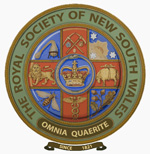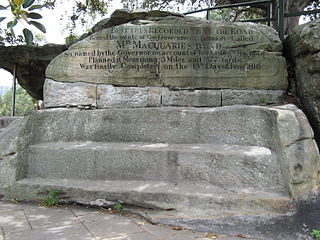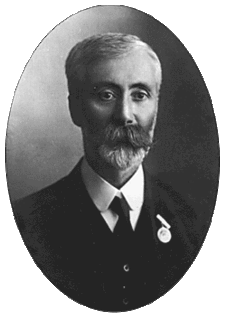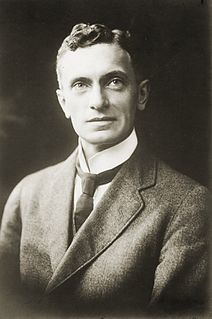Related Research Articles

The Royal Society of New South Wales is a learned society based in Sydney, Australia. The Governor of New South Wales is the vice-regal patron of the Society.

Mrs Macquarie's Chair is an exposed sandstone rock cut into the shape of a bench, on a peninsula in Sydney Harbour. It was hand carved by convicts in 1810, for Elizabeth Macquarie, the wife of Major-General Lachlan Macquarie, Governor of New South Wales. The peninsula itself was known to the Gadigal as Yurong Point, and is now widely known as Mrs Macquarie's Point, and is part of The Domain, near the Royal Botanic Gardens.

Joseph Henry Maiden was a botanist who made a major contribution to knowledge of the Australian flora, especially the genus Eucalyptus. This botanist is denoted by the author abbreviation Maiden when citing a botanical name.

Alfred Cort Haddon, Sc.D., FRS, FRGS FRAI was an influential British anthropologist and ethnologist. Initially a biologist, who achieved his most notable fieldwork, with W.H.R. Rivers, C.G. Seligman and Sidney Ray on the Torres Strait Islands. He returned to Christ's College, Cambridge, where he had been an undergraduate, and effectively founded the School of Anthropology. Haddon was a major influence on the work of the American ethnologist Caroline Furness Jayne.

Robert Hamilton Mathews (1841–1918) was an Australian surveyor and self-taught anthropologist who studied the Aboriginal cultures of Australia, especially those of Victoria, New South Wales and southern Queensland. He was a member of the Royal Society of New South Wales and a corresponding member of the Anthropological Institute of London.

The Clarke Medal is awarded by the Royal Society of New South Wales, the oldest learned society in Australia and the Southern Hemisphere, for distinguished work in the Natural sciences.
William Noel Benson FRS FRGS was an English-born research geologist and academic active first in Australia and then New Zealand. After studying geology at the University of Sydney, Benson worked temporarily at the University of Adelaide before returning to Sydney as a demonstrator. After winning an 1851 Exhibition Science Scholarship in 1910 he left Sydney to study at the University of Cambridge, where he worked until 1913. He returned to Sydney in 1914 as the Macleay Fellow in Geology, leaving in 1917 to become Chair of the Geology Department at the University of Otago, where for many years he was the only lecturer. During his lifetime he published over 100 papers and won several awards, including the Clarke Medal and the Lyell Medal. He died on 20 August 1957 following his retirement from academia in 1951.

Herbert Basedow was an Australian anthropologist, geologist, politician, explorer and medical practitioner.
On 22 June 1883, the Geographical Society of Australasia started at a meeting in Sydney. A branch was formed in Victoria in the same year. In July 1885, both the Queensland and the South Australian branches started.

James William Jones was a South Australian surveyor. He was the son of civil engineer Thomas Jones, founder of the Manchester Unity of Oddfellows in South Australia. He studied at J. L. Young's Adelaide Educational Institution. He was soon working for his father on the Port Elliot to Goolwa tramway, for which his father received official criticism. He joined the State public service as a draughtsman in 1865 and was appointed Chief Surveyor then Deputy Surveyor-General in the Department of Survey and Crown Lands. He explored the area north-east of Eucla in 1880, and discovered the Kudna rockhole and catacombs, an immense network of limestone caves, lakes and underground passages under the Nullarbor Plain. He was appointed Conservator of Water in 1887 and Secretary to the Commissioner of Works in 1902. He was secretary of the South Australia branch of the Royal Geographical Society of Australasia from its foundation in 1885 to 1894. He was elected president of the Institute of Surveyors in 1912. He was chairman and president of the Harbors and Marine Board in 1914. He was secretary of the Cheer-Up Society during the First World War.

Crawford Atchison Denman Pasco was a Royal Navy officer and Australian police magistrate during the 19th century.
Iltur is a remote Pitjantjatjara homeland in the Great Victoria Desert of South Australia. It is also known as Coffin Hill after the rocky outcrop where it is located, and the traditional country surrounding it is known in Pitjantjatjara as Ilturnga. It is located at the southern end of the Birksgate Range, and is one of the most southerly locations on the Aṉangu Pitjantjatjara Yankunytjatjara Lands. It was visited by the Elder Scientific Exploring Expedition in 1881, led by the explorer David Lindsay.
The Marranunggu are an Aboriginal Australian people and language group, of the Northern Territory.
The Barindji, also written Parrintyi, are an indigenous Australian people of the state of New South Wales. They are to be distinguished from the Paaruntyi, who spoke a similar language but whom they called the spitting people.
The Kokowara were an indigenous Australian people of the state of Queensland.
The Waluwara were an indigenous Australian people of the state of Queensland.
The Kalibal (Gullibul) were an indigenous Australian people of New South Wales.

The Australasian Anthropological Journal was a magazine issued from August 1896 to May 1897, after which time it was issued as the Science of man and Australasian anthropological journal, eventually shortened to the Science of Man until it ceased publication in 1913.

Jane Ada Fletcher (1870–1956) was a Tasmanian poet and author, publishing works on ornithology, history, anthropology, and fiction.
References
- ↑ "Royal Anthropological Society of Australasia (1885 - ?)". EOAS. Retrieved 11 February 2014.